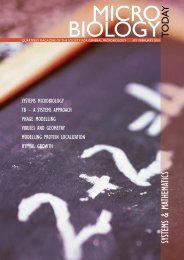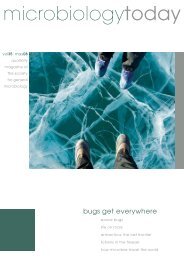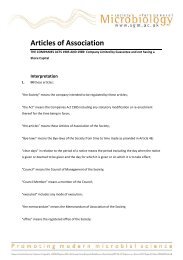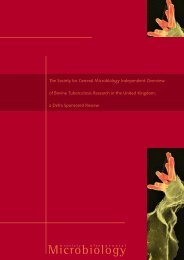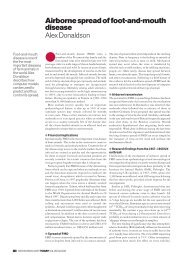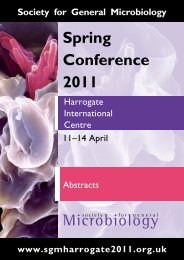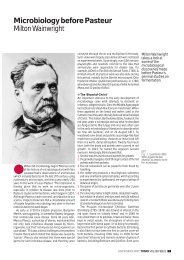Download - Society for General Microbiology
Download - Society for General Microbiology
Download - Society for General Microbiology
You also want an ePaper? Increase the reach of your titles
YUMPU automatically turns print PDFs into web optimized ePapers that Google loves.
contents<br />
vol35(4)<br />
regular features<br />
159 News 202 Schoolzone 212 Hot off the Press<br />
166 Microshorts 206 Gradline 215 Going Public<br />
199 Conferences 209 Addresses 218 Reviews<br />
other items<br />
articles<br />
168 Microbial diseases of bees<br />
Travis Glare & Maureen O’Callaghan<br />
Bees play an essential role in the world’s ecosystems, but<br />
microbial diseases are posing a big threat to these vital<br />
insects.<br />
196 National Subject Profiles<br />
210 Obituary – Professor Chris Thurston<br />
184 An inside job: Bdellovibrio<br />
bacteriovorus<br />
Liz Sockett<br />
These predatory bacteria hunt down and eat their fellow<br />
organisms.<br />
172<br />
Ancient fungal farmers<br />
of the insect world<br />
Garret Suen & Cameron<br />
Currie<br />
Leaf-cutter ants not only grow fungi to eat. They<br />
weed their ‘gardens’ and apply pesticides too.<br />
176 Bacterial sequences in an<br />
invertebrate genome<br />
Julie Dunning Hotopp & Jason Rasgon<br />
Some arthropods and nematodes need their bacterial<br />
inhabitants to survive.<br />
180 Photorhabdus: shedding light<br />
on symbioses<br />
Susan Joyce and David Clarke<br />
Which amazing microbe can make nematodes glow in the<br />
dark and yet kill certain insects?<br />
188 Bacteriophages: nature’s most<br />
successful experiment<br />
Graham Hatfull<br />
Phages could well be the world’s biggest reservoir of<br />
unidentified genetic material.<br />
192<br />
1983: a vintage year <strong>for</strong><br />
pathogen discovery<br />
Robin Weiss<br />
Important findings about three major infectious<br />
diseases were made 25 years ago.<br />
220 Comment:<br />
Scotoma in contemporary<br />
microbiology<br />
Howard Gest<br />
Are some bacteria really ‘unculturable’? Probably not<br />
according to this writer.<br />
Cover image Macrophotograph of the head of a worker honey bee (Apis mellifera). Dr Jeremy Burgess / Science Photo Library<br />
Editor Dr Matt Hutchings––Editorial Board Dr Sue Assinder, Dr Paul Hoskisson, Professor Bert Rima––Managing Editor Janet Hurst––Assistant Editors Lucy Goodchild & Faye Stokes<br />
Editorial Assistant Yvonne Taylor––Design & Production Ian Atherton––Contributions are always welcome and should be addressed to the Editor c/o SGM HQ, Marlborough House,<br />
Basingstoke Road, Spencers Wood, Reading RG7 1AG–Tel. 0118 988 1809–Fax 0118 988 5656–email mtoday@sgm.ac.uk–web www.sgm.ac.uk<br />
Advertising David Lancaster, Ten Alps Publishing, London Office, 10 Savoy Street, London WC2E 7HR–t 0207 878 2316–f 0207 379 7118–e david.lancaster@tenalpspublishing.co.uk<br />
Regular feature images pp. 159 SGM; 203, 219 Comstock / Jupiter Images; 207, 213 Stockbyte; 209 Digital Vision / Getty<br />
© 2008 The <strong>Society</strong> <strong>for</strong> <strong>General</strong> <strong>Microbiology</strong>––ISSN 1464-0570––Printed by Latimer Trend & Company Ltd, Plymouth, UK<br />
The views expressed<br />
by contributors are not<br />
necessarily those of the<br />
<strong>Society</strong>; nor can the<br />
claims of advertisers<br />
be guaranteed.



